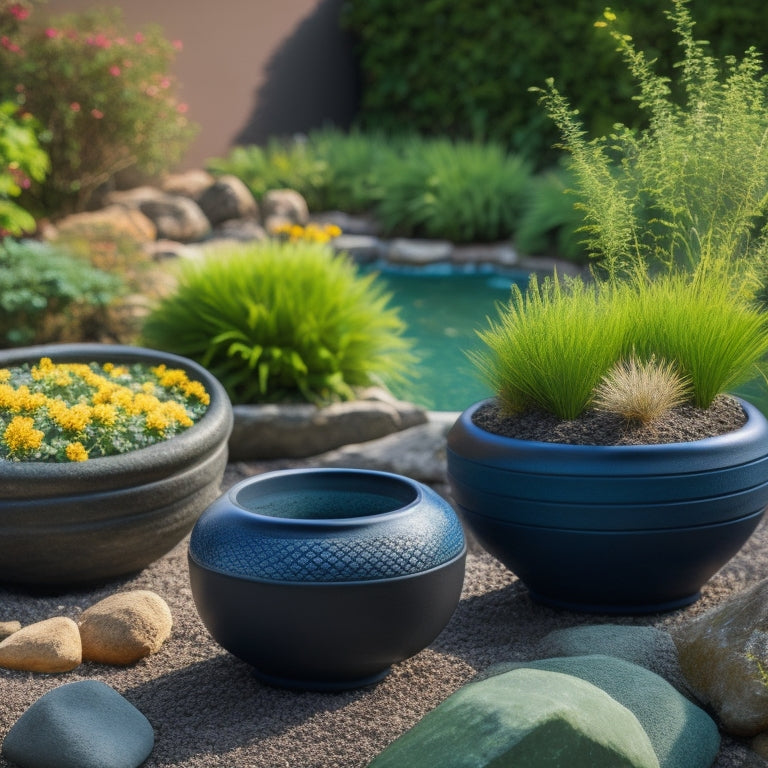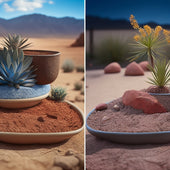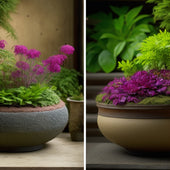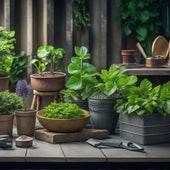
5 Best Drainage Solutions for Garden Planters
Share
You can guarantee your garden planters thrive by incorporating effective drainage solutions. Consider cinder block drainage techniques, which involve drilling holes or creating gaps to promote aeration and adding a coarse aggregate layer for excess water escape. Elevated planter systems, with a minimum 1-2 inch elevation, also promote healthy root growth. Gravel and sand layering, with a 1:1 ratio, provides a solid foundation for efficient water drainage. Hollow cinder block designs and water-directing planter bases, with sloping surfaces and multiple drainage holes, are also effective solutions. By exploring these options, you'll be well on your way to creating a prime environment for your plants to flourish.
Key Takeaways
• Drilling holes or creating gaps in cinder blocks aids aeration and promotes healthy root growth by allowing excess water to escape.
• Elevated planter systems with plastic grids or advanced materials create a well-oxygenated environment and facilitate water drainage.
• Layering gravel and sand provides a solid foundation for planters, enabling efficient water drainage and reducing the risk of root rot.
• Incorporating hollow cinder blocks with air pockets and channels enhances drainage capabilities and promotes better root growth.
• Water-directing planter bases with sloping surfaces and multiple drainage holes spaced evenly prevent water accumulation and regulate moisture levels.
Cinder Block Drainage Essentials
When building a garden planter using cinder blocks, ensuring proper drainage is essential to prevent waterlogged soil and root rot. You will want to incorporate a drainage system that allows excess water to escape.
Cinder blocks, by nature, have high moisture retention, which can lead to waterlogged soil if not addressed. To combat this, you can implement cinder block aeration techniques, such as drilling holes in the blocks or using a hammer and chisel to create small gaps. This will enable air to penetrate the blocks, reducing moisture retention and promoting healthy root growth.
Additionally, consider adding a layer of coarse aggregate, like gravel or crushed stone, at the bottom of the planter to facilitate drainage. This will help to filter excess water away from the soil and prevent waterlogging.
Elevated Planter Drainage Systems
By incorporating an elevated planter drainage system, you can create a well-oxygenated environment that allows excess water to flow freely, reducing the risk of waterlogged soil and root rot. This setup involves elevating your planter above the ground using materials like blocks, risers, or pedestals, guaranteeing that the pot's bottom is at least 1-2 inches above the surrounding surface.
This elevation enables you to install a drainage system beneath the planter, which can be as simple as a plastic grid or a more advanced system featuring drainage materials like geotextiles or aggregate.
Regular planter maintenance is essential to confirm the effectiveness of your elevated drainage system. You'll need to check the system periodically to verify it's functioning correctly and clear any debris that may accumulate.
Additionally, inspect the planter's drainage holes for clogs and clean them as needed. By doing so, you'll prevent water from accumulating in the planter and reduce the risk of root rot.
With an elevated planter drainage system, you can enjoy a healthy, thriving garden while minimizing the risk of water-related issues.
Gravel and Sand Layering
Set a solid foundation for your garden planter by layering gravel and sand at the bottom, which enables efficient water drainage and prevents waterlogged soil. This layering technique guarantees that excess water is redirected away from the roots, reducing the risk of root rot and other drainage-related issues.
When selecting gravel and sand, choose coarse, porous materials that allow for peak water flow. A general rule of thumb is to use a 1:1 ratio of gravel to sand, with the gravel layer at the bottom and the sand layer on top. This configuration enables water to flow freely through the gravel, while the sand prevents soil particles from clogging the drainage materials.
Hollow Cinder Block Design
You can take your garden planter's drainage to the next level by incorporating hollow cinder blocks into the design, which provide additional space for water to flow through and further reduce the risk of waterlogging.
By using hollow cinder blocks, you can create a network of air pockets and channels that allow excess water to escape, ensuring your plants receive the right amount of moisture. The hollow design also allows for better root growth, as roots can penetrate the blocks and access oxygen more easily.
When incorporating hollow cinder blocks into your planter design, consider the aesthetics of the blocks themselves. You can choose blocks with a decorative finish or paint them to match your outdoor decor.
Additionally, think about the planting techniques you'll use. For example, you can plant species that thrive in well-draining conditions, such as succulents or herbs, directly into the hollow blocks.
Water-Directing Planter Bases
Designing a water-directing planter base involves crafting a sloping or angled surface that facilitates the flow of excess water away from the plant's roots, thereby preventing waterlogged soil and root rot.
You'll want to ascertain the base is angled enough to allow water to flow freely, but not so steep that it compromises the planter's stability.
To achieve peak drainage, you can drill multiple drainage holes in the base, spaced evenly apart to prevent water from accumulating in any one area. The size and number of holes will depend on the planter's size and material, as well as the type of plants you're growing.
It's also essential to take into account moisture retention when designing your water-directing planter base. You can incorporate materials with high water-absorption rates, such as perlite or vermiculite, to help regulate moisture levels and prevent waterlogging.
Frequently Asked Questions
Can I Use Regular Potting Soil in Planters With Drainage Systems?
When choosing a potting soil for your planters, you're probably wondering if regular potting soil will cut it, even with a drainage system in place.
The answer lies in the soil's composition. Regular potting soils can retain too much moisture, which can still cause root rot, even with drainage.
Look for potting soil types specifically designed to balance planter moisture, such as those with added perlite or vermiculite, to guarantee your plants thrive.
How Often Should I Clean the Drainage Holes in My Planters?
As you're sipping your morning coffee, you glance out the window to see your planters overflowing with water, a coincidence that reminds you to check those drainage holes.
You should clean them every 1-2 months to prevent clogging, ensuring proper drainage maintenance.
This simple task is essential for planter health, as blocked holes can lead to root rot and other issues.
Regularly inspect and clear debris to keep your planters thriving.
Are Drainage Solutions Necessary for Small Garden Planters?
You might wonder if drainage solutions are necessary for small garden planters. The answer is yes, they're vital.
Without proper drainage, water can accumulate, causing root rot and poor planter health. Even small planters need drainage to prevent waterlogged soil, which can lead to plant stress and disease.
Don't underestimate the importance of drainage – it's essential for maintaining healthy plants and preventing water-related issues.
Can I Make My Own Drainage Solution Using Recycled Materials?
Get creative and go green! You can definitely craft your own DIY drainage solution using recycled materials.
Repurpose plastic bottles, cardboard tubes, or even old sponges to create a functional drainage system. Simply cut the materials to size, arrange them in your planter, and voilà!
You'll be reducing waste while keeping your plants happy and healthy. With a little ingenuity, you can create an effective, eco-friendly drainage solution that's both budget-friendly and environmentally responsible.
Do Drainage Solutions Work for Planters With Multiple Tiers or Layers?
When you're working with tiered planters, effective drainage is essential to prevent waterlogged soil.
You'll want to guarantee each tier has its own drainage system to avoid water accumulation.
For multi-layer irrigation, consider using a combination of materials like perlite, vermiculite, or sand to improve soil aeration and drainage.
Additionally, incorporate a drainage hole in each tier, and use a waterproof membrane to direct excess water to the next layer.
Conclusion
By incorporating one or more of these drainage solutions into your garden planters, you'll greatly reduce waterlogged soil and root rot.
Did you know that a staggering 90% of plant deaths are caused by overwatering?
By prioritizing proper drainage, you'll not only save your plants but also reduce the environmental impact of excess water usage.
With these expert-approved methods, you'll be well on your way to creating a thriving, water-efficient garden oasis.
Related Posts
-

Preventing Soil Settlement in DIY Planters
To prevent soil settlement in your DIY planters, you'll want to focus on selecting a well-balanced soil mix with good...
-

Preventing Soil Settlement in DIY Planters
To prevent soil settlement in your DIY planters, you'll want to focus on selecting a well-balanced soil mix with good...
-

Preventing Soil Settlement in DIY Planters
To prevent soil settlement in your DIY planters, you'll want to focus on selecting a well-balanced soil mix with good...
-

Preventing Soil Settlement in DIY Planters
To prevent soil settlement in your DIY planters, you'll want to focus on selecting a well-balanced soil mix with good...
-

Preventing Soil Settlement in DIY Planters
To prevent soil settlement in your DIY planters, you'll want to focus on selecting a well-balanced soil mix with good...
-

Preventing Soil Settlement in DIY Planters
To prevent soil settlement in your DIY planters, you'll want to focus on selecting a well-balanced soil mix with good...
-

Preventing Soil Settlement in DIY Planters
To prevent soil settlement in your DIY planters, you'll want to focus on selecting a well-balanced soil mix with good...
-

Preventing Soil Settlement in DIY Planters
To prevent soil settlement in your DIY planters, you'll want to focus on selecting a well-balanced soil mix with good...
-

Preventing Soil Settlement in DIY Planters
To prevent soil settlement in your DIY planters, you'll want to focus on selecting a well-balanced soil mix with good...
-

Preventing Soil Settlement in DIY Planters
To prevent soil settlement in your DIY planters, you'll want to focus on selecting a well-balanced soil mix with good...
-

Preventing Soil Settlement in DIY Planters
To prevent soil settlement in your DIY planters, you'll want to focus on selecting a well-balanced soil mix with good...
-

Preventing Soil Settlement in DIY Planters
To prevent soil settlement in your DIY planters, you'll want to focus on selecting a well-balanced soil mix with good...
-

Preventing Soil Settlement in DIY Planters
To prevent soil settlement in your DIY planters, you'll want to focus on selecting a well-balanced soil mix with good...
-

Preventing Soil Settlement in DIY Planters
To prevent soil settlement in your DIY planters, you'll want to focus on selecting a well-balanced soil mix with good...
-

Preventing Soil Settlement in DIY Planters
To prevent soil settlement in your DIY planters, you'll want to focus on selecting a well-balanced soil mix with good...
-

Preventing Soil Settlement in DIY Planters
To prevent soil settlement in your DIY planters, you'll want to focus on selecting a well-balanced soil mix with good...
-

Preventing Soil Settlement in DIY Planters
To prevent soil settlement in your DIY planters, you'll want to focus on selecting a well-balanced soil mix with good...
-

Preventing Soil Settlement in DIY Planters
To prevent soil settlement in your DIY planters, you'll want to focus on selecting a well-balanced soil mix with good...
-

Preventing Soil Settlement in DIY Planters
To prevent soil settlement in your DIY planters, you'll want to focus on selecting a well-balanced soil mix with good...
-

Preventing Soil Settlement in DIY Planters
To prevent soil settlement in your DIY planters, you'll want to focus on selecting a well-balanced soil mix with good...
-

Preventing Soil Settlement in DIY Planters
To prevent soil settlement in your DIY planters, you'll want to focus on selecting a well-balanced soil mix with good...
-

Preventing Soil Settlement in DIY Planters
To prevent soil settlement in your DIY planters, you'll want to focus on selecting a well-balanced soil mix with good...
-

Preventing Soil Settlement in DIY Planters
To prevent soil settlement in your DIY planters, you'll want to focus on selecting a well-balanced soil mix with good...
-

Preventing Soil Settlement in DIY Planters
To prevent soil settlement in your DIY planters, you'll want to focus on selecting a well-balanced soil mix with good...
-

What to Seal Your Planters With for Longevity
When sealing your planters for longevity, it's vital to choose a sealant compatible with your planter material - whet...
-

What to Seal Your Planters With for Longevity
When sealing your planters for longevity, it's vital to choose a sealant compatible with your planter material - whet...
-

What to Seal Your Planters With for Longevity
When sealing your planters for longevity, it's vital to choose a sealant compatible with your planter material - whet...
-

What to Seal Your Planters With for Longevity
When sealing your planters for longevity, it's vital to choose a sealant compatible with your planter material - whet...
-

What to Seal Your Planters With for Longevity
When sealing your planters for longevity, it's vital to choose a sealant compatible with your planter material - whet...
-

What to Seal Your Planters With for Longevity
When sealing your planters for longevity, it's vital to choose a sealant compatible with your planter material - whet...
-

What to Seal Your Planters With for Longevity
When sealing your planters for longevity, it's vital to choose a sealant compatible with your planter material - whet...
-

What to Seal Your Planters With for Longevity
When sealing your planters for longevity, it's vital to choose a sealant compatible with your planter material - whet...
-

What to Seal Your Planters With for Longevity
When sealing your planters for longevity, it's vital to choose a sealant compatible with your planter material - whet...
-

What to Seal Your Planters With for Longevity
When sealing your planters for longevity, it's vital to choose a sealant compatible with your planter material - whet...
-

What to Seal Your Planters With for Longevity
When sealing your planters for longevity, it's vital to choose a sealant compatible with your planter material - whet...
-

What to Seal Your Planters With for Longevity
When sealing your planters for longevity, it's vital to choose a sealant compatible with your planter material - whet...
-

What to Seal Your Planters With for Longevity
When sealing your planters for longevity, it's vital to choose a sealant compatible with your planter material - whet...
-

What to Seal Your Planters With for Longevity
When sealing your planters for longevity, it's vital to choose a sealant compatible with your planter material - whet...
-

What to Seal Your Planters With for Longevity
When sealing your planters for longevity, it's vital to choose a sealant compatible with your planter material - whet...
-

What to Seal Your Planters With for Longevity
When sealing your planters for longevity, it's vital to choose a sealant compatible with your planter material - whet...
-

What to Seal Your Planters With for Longevity
When sealing your planters for longevity, it's vital to choose a sealant compatible with your planter material - whet...
-

What to Seal Your Planters With for Longevity
When sealing your planters for longevity, it's vital to choose a sealant compatible with your planter material - whet...
-

What to Seal Your Planters With for Longevity
When sealing your planters for longevity, it's vital to choose a sealant compatible with your planter material - whet...
-

What to Seal Your Planters With for Longevity
When sealing your planters for longevity, it's vital to choose a sealant compatible with your planter material - whet...
-

What to Seal Your Planters With for Longevity
When sealing your planters for longevity, it's vital to choose a sealant compatible with your planter material - whet...
-

What to Seal Your Planters With for Longevity
When sealing your planters for longevity, it's vital to choose a sealant compatible with your planter material - whet...
-

What to Seal Your Planters With for Longevity
When sealing your planters for longevity, it's vital to choose a sealant compatible with your planter material - whet...
-

What to Seal Your Planters With for Longevity
When sealing your planters for longevity, it's vital to choose a sealant compatible with your planter material - whet...
-

What to Seal Your Planters With for Longevity
When sealing your planters for longevity, it's vital to choose a sealant compatible with your planter material - whet...
-

What to Seal Your Planters With for Longevity
When sealing your planters for longevity, it's vital to choose a sealant compatible with your planter material - whet...
-

What to Seal Your Planters With for Longevity
When sealing your planters for longevity, it's vital to choose a sealant compatible with your planter material - whet...
-

What to Seal Your Planters With for Longevity
When sealing your planters for longevity, it's vital to choose a sealant compatible with your planter material - whet...
-

What to Seal Your Planters With for Longevity
When sealing your planters for longevity, it's vital to choose a sealant compatible with your planter material - whet...
-

What to Seal Your Planters With for Longevity
When sealing your planters for longevity, it's vital to choose a sealant compatible with your planter material - whet...
-

What to Seal Your Planters With for Longevity
When sealing your planters for longevity, it's vital to choose a sealant compatible with your planter material - whet...
-

What to Seal Your Planters With for Longevity
When sealing your planters for longevity, it's vital to choose a sealant compatible with your planter material - whet...
-

Why Do Cinder Block Planter Tools Cost So Much
You'll likely spend at least $200 to $500 on essential tools for a DIY cinder block planter project, with high-end op...
-

Why Do Cinder Block Planter Tools Cost So Much
You'll likely spend at least $200 to $500 on essential tools for a DIY cinder block planter project, with high-end op...
-

Why Do Cinder Block Planter Tools Cost So Much
You'll likely spend at least $200 to $500 on essential tools for a DIY cinder block planter project, with high-end op...
-

Why Do Cinder Block Planter Tools Cost So Much
You'll likely spend at least $200 to $500 on essential tools for a DIY cinder block planter project, with high-end op...
-

Why Do Cinder Block Planter Tools Cost So Much
You'll likely spend at least $200 to $500 on essential tools for a DIY cinder block planter project, with high-end op...
-

Why Do Cinder Block Planter Tools Cost So Much
You'll likely spend at least $200 to $500 on essential tools for a DIY cinder block planter project, with high-end op...
-

Why Do Cinder Block Planter Tools Cost So Much
You'll likely spend at least $200 to $500 on essential tools for a DIY cinder block planter project, with high-end op...
-

Why Do Cinder Block Planter Tools Cost So Much
You'll likely spend at least $200 to $500 on essential tools for a DIY cinder block planter project, with high-end op...
-

Why Do Cinder Block Planter Tools Cost So Much
You'll likely spend at least $200 to $500 on essential tools for a DIY cinder block planter project, with high-end op...
-

Why Do Cinder Block Planter Tools Cost So Much
You'll likely spend at least $200 to $500 on essential tools for a DIY cinder block planter project, with high-end op...
-

Why Do Cinder Block Planter Tools Cost So Much
You'll likely spend at least $200 to $500 on essential tools for a DIY cinder block planter project, with high-end op...
-

Why Do Cinder Block Planter Tools Cost So Much
You'll likely spend at least $200 to $500 on essential tools for a DIY cinder block planter project, with high-end op...
-

Why Do Cinder Block Planter Tools Cost So Much
You'll likely spend at least $200 to $500 on essential tools for a DIY cinder block planter project, with high-end op...
-

Why Do Cinder Block Planter Tools Cost So Much
You'll likely spend at least $200 to $500 on essential tools for a DIY cinder block planter project, with high-end op...
-

Why Do Cinder Block Planter Tools Cost So Much
You'll likely spend at least $200 to $500 on essential tools for a DIY cinder block planter project, with high-end op...
-

Why Do Cinder Block Planter Tools Cost So Much
You'll likely spend at least $200 to $500 on essential tools for a DIY cinder block planter project, with high-end op...
-

Why Do Cinder Block Planter Tools Cost So Much
You'll likely spend at least $200 to $500 on essential tools for a DIY cinder block planter project, with high-end op...
-

Why Do Cinder Block Planter Tools Cost So Much
You'll likely spend at least $200 to $500 on essential tools for a DIY cinder block planter project, with high-end op...
-

Why Do Cinder Block Planter Tools Cost So Much
You'll likely spend at least $200 to $500 on essential tools for a DIY cinder block planter project, with high-end op...
-

Why Do Cinder Block Planter Tools Cost So Much
You'll likely spend at least $200 to $500 on essential tools for a DIY cinder block planter project, with high-end op...
-

Why Do Cinder Block Planter Tools Cost So Much
You'll likely spend at least $200 to $500 on essential tools for a DIY cinder block planter project, with high-end op...
-

Why Do Cinder Block Planter Tools Cost So Much
You'll likely spend at least $200 to $500 on essential tools for a DIY cinder block planter project, with high-end op...
-

Why Do Cinder Block Planter Tools Cost So Much
You'll likely spend at least $200 to $500 on essential tools for a DIY cinder block planter project, with high-end op...
-

Why Do Cinder Block Planter Tools Cost So Much
You'll likely spend at least $200 to $500 on essential tools for a DIY cinder block planter project, with high-end op...
-

Why Do Cinder Block Planter Tools Cost So Much
You'll likely spend at least $200 to $500 on essential tools for a DIY cinder block planter project, with high-end op...
-

Why Do Cinder Block Planter Tools Cost So Much
You'll likely spend at least $200 to $500 on essential tools for a DIY cinder block planter project, with high-end op...
-

Why Do Cinder Block Planter Tools Cost So Much
You'll likely spend at least $200 to $500 on essential tools for a DIY cinder block planter project, with high-end op...
-

Why Do Cinder Block Planter Tools Cost So Much
You'll likely spend at least $200 to $500 on essential tools for a DIY cinder block planter project, with high-end op...
-

Why Do Cinder Block Planter Tools Cost So Much
You'll likely spend at least $200 to $500 on essential tools for a DIY cinder block planter project, with high-end op...
-

Why Do Cinder Block Planter Tools Cost So Much
You'll likely spend at least $200 to $500 on essential tools for a DIY cinder block planter project, with high-end op...
-

Why Do Cinder Block Planter Tools Cost So Much
You'll likely spend at least $200 to $500 on essential tools for a DIY cinder block planter project, with high-end op...


